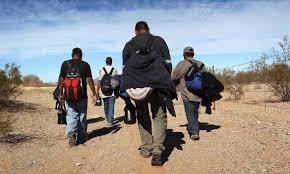Panama’s government is touting progress on efforts to reduce illegal migration through the Darien Gap, a dense jungle region that long has served as a gateway point for South American migrants making their way to the United States.
The National Border Service, Panama’s version of the U.S. Border Patrol, reported that 11,363 migrants had crossed into the country from Colombia since July 1, when Panamanian President Jose Raul Mulino first entered office, The Associated Press reported. That number marks roughly 9,000 fewer crossings compared to the same period last year.
Jorge Gobea, the National Border Service’s director general, credited the downturn in migration numbers to the construction of around 3 miles of barbed wire on five different trails frequently used by migrants passing through the Darien Gap, according to AP. Gobea also pointed to the Panama government’s declaration of deportation plans as well as heavy rains as the reasons for the drop-off in migration numbers.
The early data comes as good news for Mulino, who was elected earlier this year on a pledge to reduce illegal immigration through Panama and immediately set out on a plan to counter the migration.
Mulino won Panama’s presidential election in May, beating his closest rival by nearly 10 percentage points, riding a wave of voter discontent over the nation’s sluggish economic growth and an endorsement from the still-popular former president. The 65-year-old lawyer also campaigned on a pledge to crack down on illegal immigration through the Darien Gap.
The Darien Gap, a vast jungle region that stretches between Colombia and southern Panama, has proven to be a paramount transit area for illegal migrants headed for the U.S.-Mexico border. Over half a million migrants crossed the Darien Gap on their northward journey to the U.S. in 2023, according to the Council on Foreign Relations.
Over 212,000 migrants entered Panama after crossing through the Darien Gap so far this year, according to the AP. The vast majority are Venezuelan nationals, while other foreign nationals include Colombians, Ecuadorians, and Chinese.
“The border of the United States, instead of being in Texas, moved to Panama,” then-candidate Mulino said on the campaign trail. “We’re going to close the Darien and we’re going to repatriate all these people.”
Mulino’s position on illegal immigration marks a major shift from the previous administration in Panama, which largely sought to assist migrants’ journey to the Costa Rican border in lieu of blocking them and returning them to their home countries.
On July 1, the day Mulino was sworn in, his government signed a deal with the Biden administration aiming to control the level of migration.
The memorandum of understanding between the two governments calls for a deployment of American screening officers to assist Panamanian officials in deporting migrants crossing the Darien Gap, according to the plan. U.S. Department of Homeland Security officials with asylum-screening experience will be deployed to Panama to help its government process migrants, and the U.S. will provide funds to beef up Panama’s deportation capabilities.
Although migration through the Darien Gap remains close to what was witnessed last year, U.S. officials have yet to fully implement their bilateral agreement, leaving room for more progress.
Efforts to control the migration routes running through the Darien Gap would have a major impact on U.S. immigration enforcement officials, who continue to deal with an ongoing border crisis.
More than 7 million migrants have crossed the U.S.-Mexico border illegally since President Joe Biden entered office in January 2021, according to the latest data from U.S. Customs and Border Protection. (https://www.dailysignal.com/2024/07/22/new-central-american-president-follows-through-on-pledge-to-cut-illegal-immigration-to-us/)



































